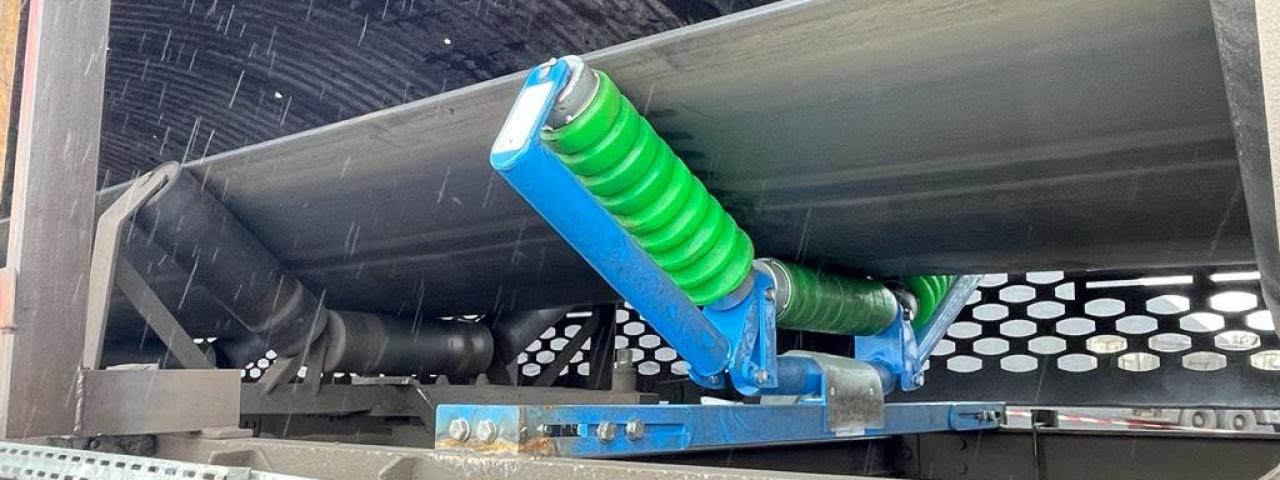

Helpful Tips and Solutions for Tracking a Conveyor Belt
WHAT IS CONVEYOR BELT TRACKING?
Conveyor belt tracking is the process of ensuring that a conveyor belt operates along its designated path without deviating. This involves adjusting various components of the conveyor system, such as pulleys, idlers, and tensioning devices, to maintain the belt's straight trajectory.
COMMON CONVEYOR BELT TRACKING ISSUES
The first step in troubleshooting conveyor belt tracking problems is to identify the possible root causes of misalignment. These tracking issues can occur due to various mechanical, operational, and environmental factors. Below are some of the most common reasons for conveyor belt mistracking.
UNEVEN BELT TENSION
Belt misalignment often stems from imbalanced tension across the width of the belt. When one side is tighter than the other, the belt tends to pull towards the tighter side. This issue can arise from improper belt tensioning, uneven adjustments of the take-up, or the gradual stretching of the belt over time. Continuously operating a belt under these conditions can lead to premature wear, uneven degradation of the surface, and increased stress on pulleys and rollers.
MISALIGNED COMPONENTS
Misalignment of the pulleys, idlers, or the conveyor frame can lead to the belt running off track. When these components are not properly aligned with the belt, they create lateral forces that push the belt away from its intended path. Even minor alignment issues can cause the belt to drift. Regular inspections and adjustments are essential to ensure that all structural elements remain correctly aligned.
CARRYBACK
Dirt, debris, and residue from transported materials can accumulate on pulleys, rollers, or the surface of the conveyor belt itself. This build-up can lead to inconsistent movement, which affects belt alignment and increases maintenance needs. Implementing effective conveyor belt cleaning systems and conducting regular maintenance can help mitigate this
DAMAGED OR WORN BELT EDGES
A conveyor belt with frayed, cracked, or uneven edges is more likely to drift off its track. Wear and tear on the belt, which can result from abrasive materials, improper tensioning, or misaligned tracking systems, may worsen existing alignment issues. Regular inspections and prompt repairs can help prevent further damage and reduce the risk of mistraking.
IMPROPER LOADING
Overloading or uneven distribution of materials on the conveyor belt can create an imbalance, causing the belt to pull toward the heavier side. Over time, this may result in tracking inconsistencies and put unnecessary stress on the belt and its components. To maintain balanced tracking, it is important to ensure proper material distribution and to use guiding mechanisms at the loading points.
HOW TO TRACK A CONVEYOR BELT?
Effective belt tracking begins with adhering to the following conditions:
The supporting structure must be robust and securely anchored.
Pulleys and rollers should be positioned at precise right angles to the belt's path. Adjustments to pulleys or rollers should only be made after the belt has completed a proper run-in period.
All components in contact with the belt should be kept clean and free of debris. Regular cleaning is highly recommended.
Below, we outline the key steps to conduct the conveyor belt tracking procedure.
INSPECT YOUR CONVEYOR SYSTEM
Start with a comprehensive inspection of your conveyor system. Examine the belt for any visible signs of wear, such as frayed edges or stretching. Inspect the pulleys, rollers, and idlers for any damage or accumulated debris. Ensure that the loading points of the belt are functioning correctly and that materials are being loaded onto the belt properly. Replace any defective components and verify that the belt lacing is intact and securely fastened, if applicable.
ADJUST THE TENSION
Ensure that thebelt tension is evenly distributed across the entire width of the belt. Use the conveyor's tensioning system to make adjustments, confirming that both sides are tensioned uniformly. Be careful not to over-tighten, as this can damage the belt. Regular checks and adjustments will help maintain optimal belt tension over time.
ALIGN PULLEYS AND IDLERS
Use a straightedge, laser alignment tools, or a level to verify the alignment of pulleys, idlers, and frames. Make necessary adjustments to ensure they are square to the belt's running direction.
CLEAN COMPONENTS REGULARLY
Regular cleaning is crucial to prevent material build-up. To achieve this, it’s important to establish a routine maintenance schedule that includes removing any dirt, debris, or accumulated residue from the belt, pulleys, rollers, and other system components. Additionally, inspect the belt scrapers and cleaners to ensure they are functioning properly.
USE TRACKING DEVICES
Installing tracking devices such as guide rollers, edge trackers, and automatic tracking systems can significantly improve belt alignment. These devices are capable of detecting and correcting minor deviations automatically, reducing the need for manual intervention. They are especially beneficial for long conveyor systems or in applications where tracking challenges frequently arise. The choice of the right tracking device will depend on your specific conveyor setup and operational needs.
At MLT, we have developed an ideal belt tracking system to ensure your belts remain aligned and operate efficiently: the StarTracker™. Suitable for both flat and troughing conveyors, this innovative self-tracking system features an anti-clogging skirt and retaining locks for the idlers. It is a practical and cost-effective solution, available in multiple dimensions, widths, and shapes, making it customizable for any conveyor configuration.
PERFORM TEST RUNS
After making the necessary adjustments, test the system by operating the conveyor belt at its intended speed. Observe its behavior to ensure that it maintains a straight path along the system. If needed, make additional minor adjustments to fine-tune the tracking. Continuous monitoring during these initial test runs is crucial, as it helps ensure that the belt stays aligned under real working conditions and prevents unexpected tracking issues during operation.
Proper conveyor belt tracking is vital for maintaining the efficiency, safety, and longevity of conveyor systems. With the right approach and tools, you can ensure that your conveyor belt runs smoothly, avoiding the challenges associated with misalignment.

Did you know?
Content
MLT offers audit services. Our conveyor experts can come to your site to carry out a comprehensive assessment of your conveyors: condition of belts, alignment, component wear, sensitive areas, etc. Following this assessment, you will receive an audit report with proposals of targeted corrective actions to improve the reliability of your installations.


